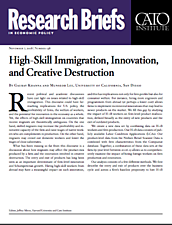Recent political and academic discussions have cast light on issues related to high-skill immigration. This discourse could have farreaching implications for U.S. policy, the profitability of firms, the welfare of workers, and the potential for innovation in the economy as a whole. Yet, the effects of high-skill immigration on countries that receive migrants are theoretically ambiguous. On the one hand, skilled migrants may increase the profitability and innovative capacity of the firm and raise wages of native workers who are complements in production. On the other hand, migrants may crowd out domestic workers and lower the wages of close substitutes.
What has been missing so far from this discourse is a discussion about how migrants may affect the product-mix produced by a firm and the innovation involved in creative destruction. The entry and exit of products has long been seen as an important determinant of firm-level innovation and Schumpeterian growth. Hiring high-skill workers from abroad may have a meaningful impact on such innovation, and this has implications not only for firm profits but also for consumer welfare. For instance, hiring more engineers and programmers from abroad (at perhaps a lower cost) allows firms to implement incremental innovations that may lead to newer products on the market. We fill this gap by studying the impact of H‑1B workers on firm-level product reallocation, defined broadly as the entry of new products and the exit of outdated products.
We create a new data set by combining data on H‑1B workers and firm production. Our H‑1B data consists of publicly available Labor Condition Applications (LCAs). Our product-level data from the Nielsen Retail Scanner Data is combined with firm characteristics from the Compustat database. Together, a combination of these data sets at the firm-by-year level between 2006–15 allows us to comprehensively examine the impact of hiring foreign workers on firm production and innovation.
Our analysis consists of a few different methods. We first describe the entry and exit of products over the business cycle and across a firm’s baseline propensity to hire H‑1B workers. We find that product reallocation falls precipitously in times of recession and rises in periods of economic recovery. Moreover, product reallocation is strongly associated with the baseline propensity to hire H‑1B workers: firms that hired H‑1B workers in the first year of our LCA data are more likely to consistently have high product reallocation rates over the business cycle. Indeed, this association is invariant to a firm’s research and development (R&D) expenditure, size, or revenue share. R&D expenditure and revenue are no longer strong determinants of product entry and exit after accounting for baseline propensities to hire H‑1B workers.
We then account for firm-level characteristics that are stable over time and for shocks that affect the economy widely. We show that an increase in product reallocation is strongly associated with higher firm revenue growth.
We find that the number of LCAs, the number of certified workers, and the number of workers as a fraction of the total firm employment base is strongly associated with reallocation rates. A 1 percent increase in the share of workers from certified LCAs is associated with a 5 percent increase in the reallocation rate. This association is stronger for software workers than other occupation groups. We also see that even as future H‑1B hiring does not affect current reallocation rates, current H‑1B hiring does affect future reallocation rates.
NOTE:
This research brief is based on Gaurav Khanna and Munseob Lee, “High-Skill Immigration, Innovation, and Creative Destruction,” in The Role of Immigrants and Foreign Students in Science, Innovation, and Entrepreneurship, eds. Ina Ganguli, Shulamit Kahn, Megan MacGarvie (Chicago: Chicago University Press, 2018), https://papers.nber.org/books/gang‑1.
About the Authors

This work is licensed under a Creative Commons Attribution-NonCommercial-ShareAlike 4.0 International License.
